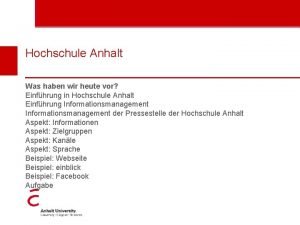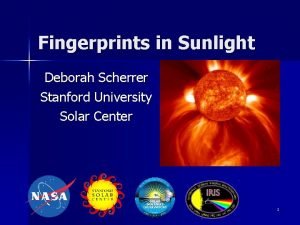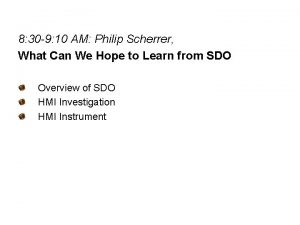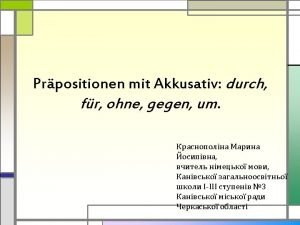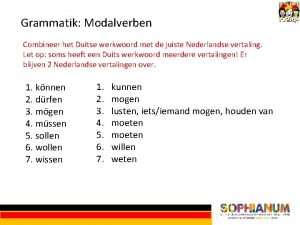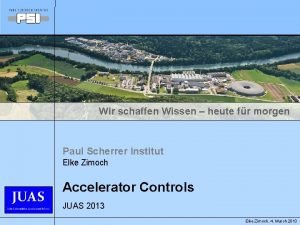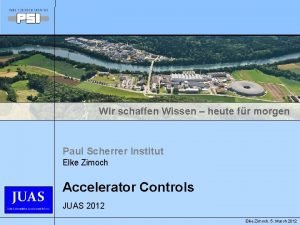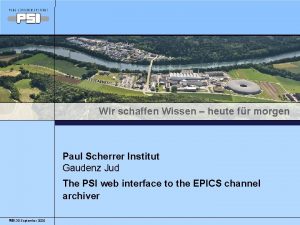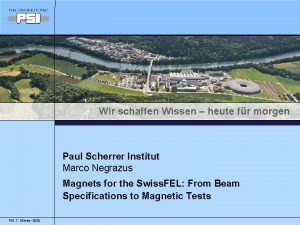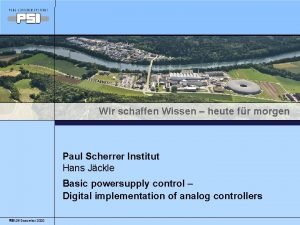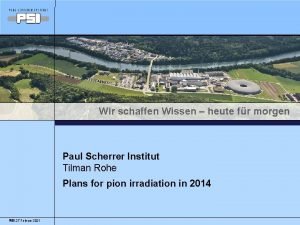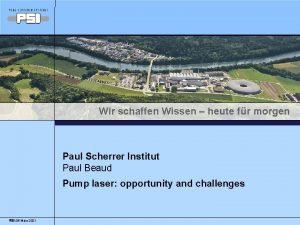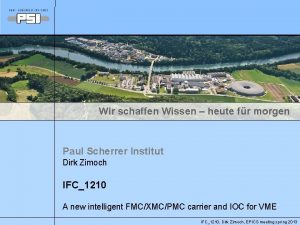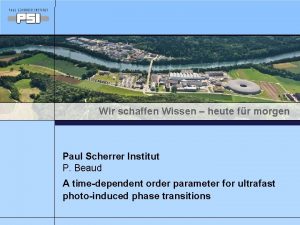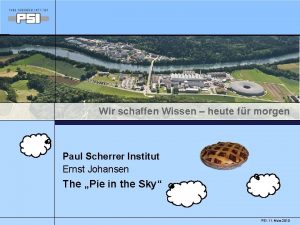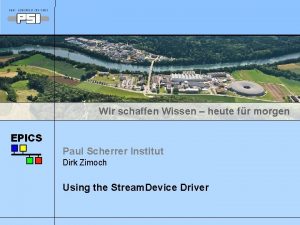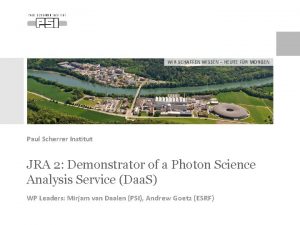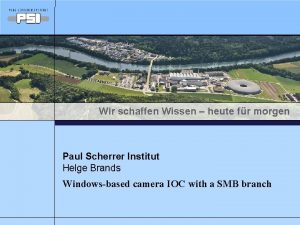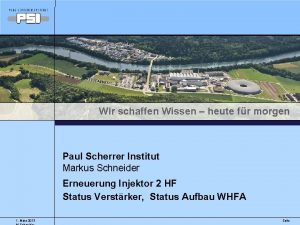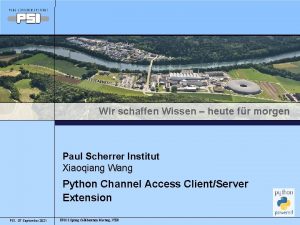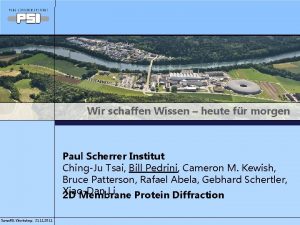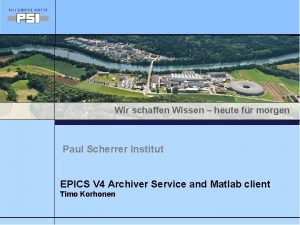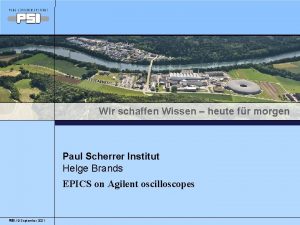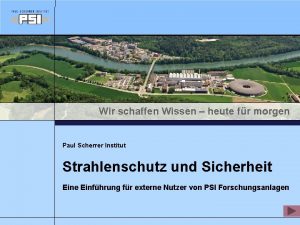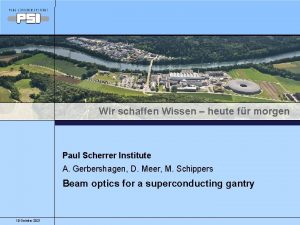Wir schaffen Wissen heute fr morgen Paul Scherrer






















- Slides: 22

Wir schaffen Wissen – heute für morgen Paul Scherrer Institut Davide Reggiani Extraction, Transport and Collimation of the PSI 1. 3 MW Proton Beam PSI, 05 05 November 2020

Outline • Introduction to the PSI High Intensity Proton Accelerator (HIPA) • Extraction from the Ring Cyclotron • Beam Transfer to the Meson Production Targets M and E • Collimation and Transfer to the Neutron Spallation Source SINQ • 1. 3 MW Beam Switchover to the UCN source

The PSI Proton Accelerator Facility • CW, 590 Me. V, 2. 2 m. A (1. 3 MW) to meson production targets M and E (7 beam lines) • CW, 575 Me. V, 1. 5 m. A (0. 86 MW) to neutron spallation target SINQ (18 beam lines) • Macro-Pulsed, 1% duty-cycle, 590 Me. V, 2. 2 m. A (1. 3 MW) to UCN target (3 beam lines) • Upgrade program towards 3. 0 m. A (1. 8 MW) launched! SINQ Target 870 ke. V Cockcroft. Walton Target E Target M 72 Me. V Injector 590 Me. V Ring Cyclotron UCN Target

Extraction from Ring Cyclotron Extraction electrode placed between last two turns HV 0 Extraction losses: limiting factor of any high power cyclotron! Losses minimization through: • «Thin» extraction device • Large turn separation PSI, 05. 11. 2020 Turn separation • Radius increment per turn Orbit Radius: Energy gain per turn: Large Machine! Powerful RF System! Higer Energy disadvantageous Limit: E < 1 Ge. V • Off-center orbit Extraction: Exploit betatron oscillation to increase turn separation by a factor of 3! Seite 4

Turn Separation at PSI Ring • Aceleration term: at exctraction R = 4460 mm, Ut= 3 Me. V, γ = 1. 63 ≈ 6 mm • Including off center orbit extraction: ΔR = 18 mm See Talk by M. Seidel: TH 01 C 01 Y. J. Bi et al. , Proceedings HB 2010 PSI, 05 05 November 2020 Seite 5

Principle of Extraction Channel 590 Me. V Beam Exctraction Line EEC: Electrostatic Extraction Channel Gap = 16 mm θbeam = 8. 2 mrad Extraction Efficency: 99. 98 % PSI, 05 November 2020 Seite 6

The 590 Me. V Proton Channel SINQ Spallation Source Cu. Collimator SINQ Beam. Dump Target E Target M UCN Beam. Dump UCN Kicker UCN Spallation Source PSI, 05. 11. 2020 Septum Seite 7

1. 3 MW Beam Transport 1. 3 MW Beam Envelopes from Cyclotron Extraction to SINQ Target (with Magnet and Collimator Apertures) y (mm) Black arrows: collimator apertures 120 SINQTarge t 68% losses 80 εy = 31. 0π 40 εy = 6. 3π εy = 1. 8π εx = 4. 7π εx = 6. 7π 40 εx = 12. 0π 80 120 x (mm) εx, εy emittance in mm·mrad 25 Target M: 1. 5% losses Target E: 30% losses 50 75 100 z (m) Peak beam current density on target M and E: 200 k. W/mm 2 Average losses away from targets: 0. 6 W/m PSI, 05. 11. 2020 Seite 8

Target-M Design Tempertur e Sensors Vacuum Chambe r Graphit e Wheel PSI, 05. 11. 2020 Shielding Collimator P-Beam Drive. Motor Specifications: Mean diameter: 320 mm Target thickness: 5. 2 mm Target width: 20 mm Graphite density: 1. 8 g/cm 3 Beam loss: 1. 6 % Power deposition: 2. 4 k. W/m. A Operating Temperature: K 1100 Irradiation damage rate: dpa/Ah 0. 12 Rotational Speed: Turn/s 1 Current limit: 5 m. A Life time: h 50000 Seite 9

Target-E Design Target width: 6 mm, Beam width (1σ) ≈ 1 mm Beam transverse range ≈ 4 mm New design (2003): gaps allow dimensional changes of the irradiated part of the graphite TARGET WHEEL Mean diameter: PBeam Graphite density: 600 K PSI, 05. 11. 2020 1. 8 g/cm 3 Operating Temperature: 1700 K Irradiation damage rate: dpa/Ah 0. 1 Rotational Speed: 1700 K 450 mm 1 Turn/s Target thickness: (7 g/cm 2) 40 mm Beam loss: 12 % Power deposition: k. W/m. A 20 Cooling: Temperature distribution simulation Radiation Seite 10

Target E Region Target Wheel 12% beam loss Backward Schielding Target Chamber Collimators 0&1 2% beam loss Collimators 2&3 15% beam loss p. Beam PSI, 05. 11. 2020 Seite 11

150 k. W on a Collimator! Temperature Effect KHE 2 Collimator during installation (1990) KHE 2 Temperature Distr. for 2. 0 m. A Proton Beam on Target E Tmax = 653 K, safe till 770 K (~2. 6 m. A) Y. Lee et al. , Proceedings HB 2010 …and after 20 years operation (120 Ah total beam charge) PSI, 05. 11. 2020 Do we need a new collimator or a new running strategy for 3. 0 m. A? Seite 12

150 k. W on a Collimator! Activation collimator probe position Dose rate up to 500 Sv/h measured at KHE 2 during inspection in March 2010!! PSI, 05. 11. 2020 Seite 13

Beam Transport to SINQ 700 k. W beam dump (1 MW beam on target E) Vertical bending plane H and V movable slits (halo scrapers) PSI, 05. 11. 2020 Beam distribution at SINQ target Collimators protect beam line from neutron back scattering Seite 14

Feasibility Study: SINQ Beam Rotation System Peak current density on the SINQ target could become an issue in view of an intensity upgrade → Consider a beam flattening system: • Non linear elements (i. e. octupoles): distort beam footprint • Fast beam rotation system: seems a good option. Simulation results: beam distribution on SINQ Simulation strategy • BRS-Location: ~25 m upstream of SINQ target • Losses from rotating beam must not be larger than standard case without rotation with rotation: ~ 50% less beam current density in the central cm 2 PSI, 05. 11. 2020 Seite 15

Machine Protection System • 1. 3 MW proton beam with σx = σy ≈ 1 mm [→ TM and TE regions] melts beam pipe in ≈ 10 ms • PSI MPS stops the beam in < 5 ms • MPS gets signals from: • Magnet power supplies • • Beam loss monitors (110 ion chambers) See Talk by P. A. Duperrex: Current monitors TH 03 C 06 • Halo monitors • Temperature sensors (collimators) • VIMOS tungsten mesh (SINQ beam footprint) HIPA MPS Review: A. Mezger and M. Seidel, Proceedings HB 2010 PSI, 05. 11. 2020 Seite 16

UCN Beam Line 1. 3 MW Proton Macro-Pulses diverted to Ultra Colde Spallation Source (1% duty cycle, pulse-lengthmax = 8 s) PSI, 05. 11. 2020 Seite 17

UCN Pulsing Scheme: Requirements and Solutions Limit beam losses → Fast Kicker-Magnet (Rise-Time < 1 ms) Avoide machine interlock during switchover → Short (3 ms) shift of beam loss monitor interlock thresholds Check beam centering → Perform 5 ms pilot pulse before each long pulse Intensity Position 5 ms PSI, 05. 11. 2020 Seite 18

UCN Operation 22 December 2010 First successful 1 MW, 8 s long UCN Beam Pulse (after three years beam commissioning with the UCN beam dump!) 5 ms Pilot-Pulse Start 8 s Pulse Stop August 2011 Start UCN production PSI, 05. 11. 2020 Seite 19

Conclusion • Since many years the PSI 1. 3 MW proton accelerator is an established and reliable user facility • The «production» beam current has been gradually increased from 100 μA (1974) to 2. 2 m. A (2008) • High current runs at 2. 4 m. A take place for 2 shitfs (16 hours) every 14 days • At 590 Me. V, the main issues related to a further intensity increase (up to 3. 0 m. A, 1. 8 MW) are: • Extraction losses • Beam collimation/reshape after target E • Beam current distribution on SINQ target PSI, 05. 11. 2020 Seite 20

Thank you for your attention! PSI, 05 05 November 2020 Seite 21

Extraction Losses and Machine Activation Gap voltage increase: 780 k. V → 850 k. V #Turns (since 2008) = 186 Typical extraction losses at 2. 2 m. A < 500 n. A Extraction Efficency = 99. 98 % Component activation: Map interpolated from 30 measured locations 3. 0 m. A upgrade → Reduce #Turns to ~ 165 Max beam current limited by exctraction losses PSI, 05 November 2020 Seite 22
 Die merkelraute
Die merkelraute Schiri wir wissen wo dein auto steht
Schiri wir wissen wo dein auto steht Ein neuer tag beginnt bilder
Ein neuer tag beginnt bilder Winter kommt flocken fallen nieder
Winter kommt flocken fallen nieder Ingrid stephan
Ingrid stephan Was du heute machen kannst verschiebe nicht auf morgen
Was du heute machen kannst verschiebe nicht auf morgen Wenn du heute morgen gesund aufgewacht bist
Wenn du heute morgen gesund aufgewacht bist Was haben wir heute
Was haben wir heute Wievielten haben wir heute
Wievielten haben wir heute Weihnachtssymbole
Weihnachtssymbole Zünden wir ein lichtlein an
Zünden wir ein lichtlein an Wir sind nicht mehr was wir mal waren
Wir sind nicht mehr was wir mal waren Dr philip scherrer
Dr philip scherrer Solar center stanford
Solar center stanford Philip scherrer
Philip scherrer Ilse wenzl
Ilse wenzl Wissen prapositionen
Wissen prapositionen Es ist nicht genug zu wissen
Es ist nicht genug zu wissen Was wissen sie über deutschland
Was wissen sie über deutschland Bescheid wissen
Bescheid wissen Individuelles wissen
Individuelles wissen Check dein wissen ergebnisse
Check dein wissen ergebnisse Modalverben wissen
Modalverben wissen







